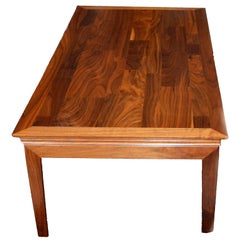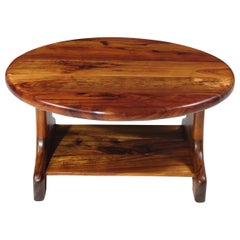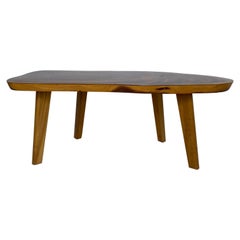Paul Ayoob
In the case of Paul Ayoob, you need only to look at the backside of the cabinet he's building. The backside that no one will ever see once the piece is installed. Go ahead. Crawl under one of his tables. Turn one of his chairs upside down. ''There aren't many people who can show the backs of their furniture,'' Ayoob says with justifiable pride. But the pieces Ayoob crafts are so seamlessly constructed and so much a product of the woodworker's attention to detail that the backs and undersides and insides indeed look just as good as the parts his clients will see every day. ''He's not just Type A,'' says his wife, Teresa Biagini. ''He's a Type AAA. But that's what makes him so good at woodwork. He's detail-oriented. He has such a high standard for himself.'' For the past quarter-century, Ayoob has put his attention to detail to use in police work. At 48, he's three years from retirement as a San Jose police officer. Police work is a daily dance with life's seamy underside, a grueling, dangerous business that can wring the energy and hope out of a person. So how has Ayoob coped? By finding a pursuit that demands exacting precision and focus, of course. ''This is my calling,'' he says of woodworking and making furniture. ''It is a peaceful interlude to my daily life. It is not just an escape. I think about it all the time. I have opted now for the peaceful side of life.'' In just a few short years, Ayoob has developed such a following, simply through referrals, that he says he has enough orders to keep him busy for two years. Though he tries, he hastens to add, to fit people into his schedule. His pieces range in price from about $2,000 to the high five figures, and his style has evolved to one he calls ''a refined but acceptable elegance.'' Of his pieces, he says, ''Their style will not wither away as the years go by.'' Ayoob, meticulous in trim jeans, a black polo shirt and boots, explains how he got his start as he shows a guest through the equally meticulous design studio he constructed behind his South Bay home. (He builds his pieces in a rented space in San Mateo County.) He pulls out life-size blueprints of a table he'll build; he works from life-size prints on each piece of furniture. Gains knowledge He sold his first commissioned piece, an entry table, in 1998. When he first tried his hand at woodworking, about seven years ago, he said, ''I didn't even know how to hammer in a nail. The first thing I built was a little rolling cabinet out of plywood. I was hammering nails through the other side, and everyone was laughing.'' Ayoob has learned much, he says, from two mentors, Jim Allen of Saratoga and David Weeks of Scotts Valley. Al Gipson, the owner of a San Jose personnel staffing agency, bought the ebony and curly maple entrance table. ''Paul was trained by old-world craftsmen. And customer care and quality was part of the package he inherited from them,'' says Gipson, who plans to commission Ayoob to make some cabinetry for a home he is building. ''I think, more than anything, it is the quality of workmanship, the detailing. He is so meticulous. He won't let you see glue seams or screws sticking out. ''He'd drive me crazy if we were roommates.'' Spousal support Allowing Ayoob, his passion has taken some forbearance on the part of his wife. The couple filled in a swimming pool so he could construct his design studio. But Biagini is proud of how her husband has blossomed. ''I love to see him develop that artistic side, that creative side in himself,'' says Biagini, a San Jose attorney. ''It's kind of exciting to see that take seed and grow in a person.'' And the Ayoob-Biagini home benefits as well, right? Well, not exactly. When Ayoob started woodworking, he made a series of coffee tables. Customers snapped them up at a yard sale. The one that cracked just a bit? That landed in the couple's home, as do the prototypes and objects that don't meet his exacting standards. ''You know that old story about the cobbler's children having no shoes?'' says Biagini. What she can track, looking at her husband's work over the last few years, is a change in his approach. In the beginning, she says, ''everything had carvings and hinges.'' ''As he has gone along, I think he's discovered the beauty of simplicity,'' she says. These days, Ayoob talks passionately about the beauty of the wood. The Honduran rosewood. The cocobolo. Ebony accents. Curly maple. And he talks about pleasing his clients, saying, ''I'm one of very few woodworkers who will design and make just what people want.'' He'll also try to work within a person's budget, constructing pieces that cost less than $2,000 if it's reasonable to do so. He spends from 40 to 250 hours on each piece and works on one piece or for one client at a time. Among the more intriguing pieces, he has constructed an oversize arts-and-crafts-style chair and ottoman that sold for five figures. Ayoob signs and dates each piece he makes. But he puts a little more into the cabinets, tables and the like as well. ''A piece of my heart leaves with every darn piece I make,'' he says.
1990s American American Craftsman Paul Ayoob
Wood
20th Century American Paul Ayoob
Wood
1960s American Vintage Paul Ayoob
Wood
1970s French Modern Vintage Paul Ayoob
Mirror, Birdseye Maple
20th Century Swiss Mid-Century Modern Paul Ayoob
Chrome, Steel
1950s American Mid-Century Modern Vintage Paul Ayoob
Wrought Iron
1940s American Mid-Century Modern Vintage Paul Ayoob
Rattan, Wood
1970s American Mid-Century Modern Vintage Paul Ayoob
Granite
1980s French Post-Modern Vintage Paul Ayoob
Glass, Mirror, Burl
20th Century Mid-Century Modern Paul Ayoob
Bronze
1950s American Mid-Century Modern Vintage Paul Ayoob
Rattan
1950s American Vintage Paul Ayoob
Rattan, Wood
1950s American Mid-Century Modern Vintage Paul Ayoob
Wood


